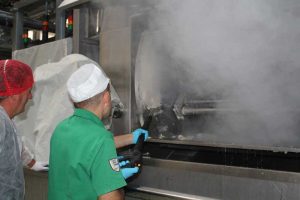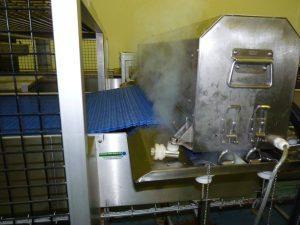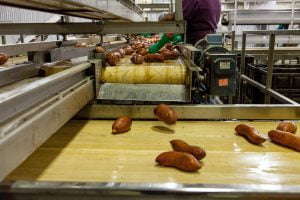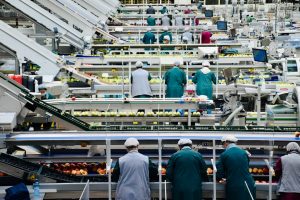Traditionally, conveyor belts have been cleaned manually using brushes, scrapers, and water. While these methods may seem effective at first glance, they have several limitations. Firstly, manual cleaning methods are time-consuming and labor-intensive, requiring workers to spend hours scrubbing the belts to remove contaminants. This can result in increased downtime and reduced productivity in food plants.
Additionally, the use of harsh chemicals and excessive amounts of water in conveyor belt cleaning can be problematic. Harsh chemicals can leave residues on the belts, which can contaminate the food being transported. Moreover, excessive water usage can lead to moisture buildup on the belts, creating an ideal environment for bacterial growth. This can further compromise food safety and increase the risk of product recalls.
The Advantages of Using a Conveyor Belt Cleaning System
To overcome the limitations of traditional cleaning methods, many food processing plants are now turning to specialized cleaning systems designed specifically for conveyor belts. These systems offer several advantages over manual cleaning methods. Firstly, they are more efficient and effective at removing contaminants from the belts. This is because they utilize advanced cleaning technologies such as steam vapour cleaning.
Furthermore, using a conveyor belt cleaning system can result in significant cost savings for food plants. By reducing the amount of time and labor required for cleaning, these systems can improve productivity and minimize downtime. Additionally, they eliminate the need for excessive water usage and harsh chemicals, reducing operational costs and environmental impact.
How Steam Vapour Cleaning Machines Work
Steam vapour cleaning machines are a popular choice for conveyor belt cleaning in food plants due to their effectiveness and efficiency. These machines utilize the power of steam to remove contaminants from the belts. The steam is produced by heating water to a high temperature, creating a dry vapor that can penetrate deep into the surface of the belts.
The steam vapour cleaning machines work by emitting a controlled flow of steam onto the conveyor belts. The steam loosens and dissolves the contaminants, making them easier to remove. The high temperature of the steam also kills bacteria and other microorganisms, ensuring a hygienic cleaning process.
Benefits of Steam Vapour Cleaning for Conveyor Belt Cleaning
| Component | Description |
|---|---|
| Boiler | Heats water to produce steam |
| Steam hose | Transfers steam from the boiler to the cleaning tool |
| Cleaning tool | Uses steam to clean surfaces |
| Pressure gauge | Measures the pressure of the steam |
| Water tank | Stores water to be heated by the boiler |
| Control panel | Allows the user to adjust the steam pressure and temperature |
| Steam nozzle | Directs the steam onto the surface being cleaned |
| Microfiber cloth | Used to wipe away dirt and grime after steam cleaning |
Using steam vapour cleaning for conveyor belt cleaning offers several benefits. Firstly, it is highly effective at removing a wide range of contaminants, including food particles, oils, grease, and bacteria. The high temperature of the steam ensures that even stubborn residues are dissolved and removed from the belts.
Moreover, steam vapour cleaning is a chemical-free and water-saving method of cleaning. It eliminates the need for harsh chemicals that can leave residues on the belts and contaminate the food being transported. Additionally, it requires minimal water usage compared to traditional cleaning methods, reducing operational costs and environmental impact.
The Automatic Conveyor Belt Steam Vacuum: A Time-Saving Solution
One innovative solution for conveyor belt cleaning is the automatic conveyor belt steam vacuum. This machine combines the power of steam vapour cleaning with vacuum technology to provide a time-saving and efficient cleaning solution for food plants.
The automatic conveyor belt steam vacuum is designed to clean conveyor belts automatically without the need for manual intervention. It is equipped with sensors that detect the presence of contaminants on the belts and activate the cleaning process. The machine emits a controlled flow of steam onto the belts, followed by a vacuum that removes the dissolved contaminants.
How the Automatic Conveyor Belt Steam Vacuum Works

The automatic conveyor belt steam vacuum consists of several components that work together to clean the belts. Firstly, there are the steam generators that produce the high-temperature steam. These generators are connected to a steam delivery system that distributes the steam onto the belts.
The machine is also equipped with a vacuum system that removes the dissolved contaminants from the belts. The vacuum system consists of suction nozzles that are positioned close to the belts to ensure efficient removal of the contaminants. The vacuumed contaminants are then collected in a separate container for disposal.
The Advantages of Using an Automatic Conveyor Belt Steam Vacuum
Using an automatic conveyor belt steam vacuum offers several advantages over traditional cleaning methods. Firstly, it eliminates the need for manual cleaning, saving time and labor costs. The machine can operate continuously, ensuring that the belts are cleaned thoroughly and efficiently.
Moreover, the automatic conveyor belt steam vacuum provides a more hygienic cleaning solution compared to manual methods. The high-temperature steam kills bacteria and other microorganisms on contact, ensuring a safe and sanitary environment in food plants. Additionally, the vacuum system removes all dissolved contaminants from the belts, preventing cross-contamination.
Case Studies: Examples of Reduced Downtime with Conveyor Belt Cleaning Systems
Several food processing plants have implemented conveyor belt cleaning systems and have experienced significant reductions in downtime and increased efficiency. For example, a large meat processing plant in the UK implemented an automatic conveyor belt steam vacuum system and saw a 50% reduction in cleaning time. This resulted in increased productivity and reduced downtime.
Similarly, a dairy processing plant in Australia implemented a specialized cleaning system for their conveyor belts and reported a 30% reduction in cleaning time. This allowed them to increase production capacity and meet growing demand for their products.
The Future of Conveyor Belt Cleaning in Food Plants
Maintaining a clean and hygienic environment in food processing plants is crucial for ensuring food safety and preventing cross-contamination. Conveyor belt cleaning plays a vital role in achieving this goal. Traditional cleaning methods have several limitations, including time-consuming manual labor and the use of harsh chemicals and excessive water.
However, with the advancement of technology, specialized cleaning systems such as steam vapour cleaning machines and automatic conveyor belt steam vacuums offer more efficient and effective solutions for conveyor belt cleaning. These systems provide numerous benefits, including improved productivity, cost savings, and enhanced food safety.
The future of conveyor belt cleaning in food plants lies in further innovation and the development of more advanced cleaning technologies. As the industry continues to prioritize food safety and efficiency, we can expect to see more sophisticated cleaning systems that offer even greater time and cost savings. With these advancements, food processing plants can ensure the highest standards of cleanliness and hygiene, ultimately protecting consumers and their brands.
FAQs
What is a conveyor belt cleaning system?
A conveyor belt cleaning system is a device or set of devices used to clean conveyor belts in industrial settings. It is designed to remove debris, dirt, and other contaminants from the belt surface to ensure that the conveyor system operates efficiently.
How does a conveyor belt cleaning system work?
A conveyor belt cleaning system typically uses a combination of mechanical, chemical, and/or thermal methods to clean the belt surface. The system may include brushes, scrapers, sprayers, or other devices that are designed to remove debris and contaminants from the belt.
Can a conveyor belt cleaning system reduce downtime in my food plant?
Yes, a conveyor belt cleaning system can help reduce downtime in a food plant by preventing belt damage and reducing the need for maintenance. By keeping the belt clean and free of debris, the system can help prevent belt slippage, belt wear, and other issues that can cause downtime.
What are the benefits of using a conveyor belt cleaning system?
The benefits of using a conveyor belt cleaning system include improved conveyor system efficiency, reduced maintenance costs, increased product quality, and improved worker safety. By keeping the belt clean and free of debris, the system can help prevent belt damage and reduce the need for maintenance.
What types of conveyor belt cleaning systems are available?
There are several types of conveyor belt cleaning systems available, including mechanical, chemical, and thermal systems. Mechanical systems use brushes, scrapers, or other devices to physically remove debris from the belt surface. Chemical systems use cleaning agents to dissolve or loosen contaminants on the belt. Thermal systems use heat to melt or evaporate contaminants on the belt surface.
How do I choose the right conveyor belt cleaning system for my food plant?
Choosing the right conveyor belt cleaning system for your food plant depends on several factors, including the type of conveyor system you have, the type of products you are handling, and the level of cleanliness required. It is important to consult with a qualified supplier or manufacturer to determine the best system for your specific needs.










